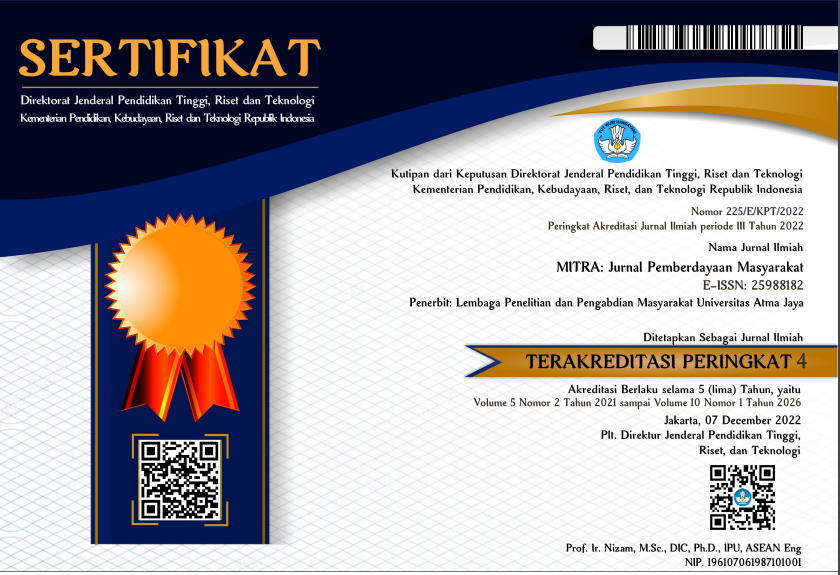Health Screening for the Primary School Students in Penjaringan District
DOI:
https://doi.org/10.25170/mitra.v6i2.2922Keywords:
children, health, screening, school, studentsAbstract
Childhood health conditions can affect individuals’ future health status, consequently influencing their performance during adulthood in contributing to the nation’s development. Some of the major health problems among many Indonesian children are poor nutrition, diarrhea, and upper respiratory tract infections, in addition to other common problems like dental caries, obesity, and ear wax. To ensure that these health problems do not persist, it is necessary to carry out early health screening to detect the children's health conditions. This screening was carried out as part of a program by the Public Health Center, namely the School Health Unit, in the form of a complete physical health examination for students from grade 1 to grade 6 at four primary schools in Penjaringan District. The health examination consists of examinations of anthropometry, eyes, skin and hair, ears, teeth and mouth, and urine. The total number of students examined was 1417 students, with 96% of them attending all examinations and as many as 26% being referred to other health facilities. With this screening, it is hoped that the students and teachers can monitor their health conditions, and in case of any health issues, they can be treated immediately. As a follow-up of this activity, the school and the Public Health Center have agreed to sign a memorandum of understanding to establish a good partnership, giving the Public Health Center an opportunity to encourage the teachers or students to care more about their health.
References
Ariaty, Y., Hengky, H. K. & Afrianty. (2019). Faktor - faktor yang mempengaruhi terjadinya miopia pada siswa/i Sd Katolik Kota Parepare. Jurnal Ilmiah Manusia dan Kesehatan, 2(3), 377–387. https://doi.org/10.31850/makes.v2i3.182
Badan Penelitian dan Pengembangan Kesehatan Kementerian Kesehatan RI. (2019). Laporan nasional Riskesdas 2018. Lembaga Penerbit Badan Penelitian dan Pengembangan Kesehatan (LPB).
Dinas Kesehatan Provinsi DKI Jakarta. (2019). Profil kesehatan provinsi DKI Jakarta Tahun 2018. Dinas Kesehatan Provinsi DKI Jakarta.
Direktorat Bina Kesehatan Anak. (2015). Petunjuk teknis penjaringan kesehatan & pemeriksaan berkala di satuan pendidikan dasar dan menengah. Direktorat Jenderal Bina Gizi dan KIA Kementerian Kesehatan RI.
Elbeltagy, R. (2020). Prevalence of mild hearing loss in schoolchildren and its association with their school performance. International Archives of Otorhinolaryngology, 24(1), E93–E98. https://doi.org/10.1055/s-0039-1695024
Faihatul Mukhbitin. (2018). Gambaran Kejadian Karies Gigi pada Siswa Kelas 3 SD. Jurnal Promkes, 6(2), 155–166. https://doi.org/10.20473/jpk.V6.I2.2018.155-16
Jackson, S. L., Vann, W. F., Kotch, J. B., Pahel, B. T., & Lee, J. Y. (2011). Impact of poor oral health on children’s school attendance and performance. American Journal of Public Health, 101(10), 1900–1906. https://doi.org/10.2105/AJPH.2010.200915
Kementerian Kesehatan RI. (2010). Telinga sehat pendengaran baik. https://www.kemkes.go.id/article/view/840/telinga-sehat-pendengaran-baik.html
Kementerian Kesehatan RI. (2014). Peraturan Menteri Kesehatan Republik Indonesia Nomor 25 Tahun 2014 tentang Upaya Kesehatan Anak. Kementerian Kesehatan RI.
Kementerian Kesehatan RI. (2016a). Pedoman umum program Indonesia Sehat dengan pendekatan keluraga. Kementerian Kesehatan RI.
Kementerian Kesehatan RI. (2016b). Peraturan Menteri Kesehatan Republik Indonesia Nomor 25 Tahun 2016 tentang Rencana Aksi Nasional Kesehatan Lanjut Usia Tahun 2016-2019. Kementerian Kesehatan RI.
Lestari, K. D., Handayani, T. A., Pemayun, C. I. D., & Manuaba, I. B. P. (2019). Karakteristik dan perbedaan kelainan refraksi pada anak usia sekolah dasar di Sekolah Dasar Cipta Dharma Denpasar Februari 2014. Medicina, 50(2), 220–225. https://doi.org/10.15562/medicina.v50i2.224
Mappadang, K., Dehoop, J., & Mengko, S. K. (2015). Survei kesehatan telinga pada anak Pasar Bersehati Komunitas Dinding Manado. E-CliniC, 3(1), 328–332. https://doi.org/10.35790/ecl.3.1.2015.6838
Norfai, & Rahman, E. (2017). Hubungan pengetahuan dan kebiasaan menggosok gigi dengan kejadian karies gigi di SDI Darul mu’minin kota Banjarmasin Tahun 2017. Dinamika Kesehatan, Vol. 8 No.(1), 212–218.
Oklita Anggiruling, D., Ekayanti, I., Khomsan Departemen Gizi Masyarakat, A., Ekologi Manusia, F., & Pertanian Bogor, I. (2019). Analisis faktor pemilihan jajanan, kontribusi gizi dan status gizi siswa sekolah dasar. Jurnal Mkmi, 15(1). https://doi.org/10.30597/mkmi.v15i1.5914
Rahmat, A., Smith, M. Bin, & Rahim, M. (2016). Perilaku hidup sehat dan prestasi belajar siswa sekolah dasar. Psympathic : Jurnal Ilmiah Psikologi, 2(2), 113–122. https://doi.org/10.15575/psy.v2i2.452
Yasin, Z., Muslim, I., & Budyantoro. (2020). Faktor predisposisi yang mempengaruhi karies gigi pada anak usia sekolah dasar Di SDN Marengan Laok I Kabupaten Sumenep. Stomagtognatic, 17(1), 25–28. https://doi.org/10.19184/stoma.v17i1.23609
Downloads
Published
How to Cite
Issue
Section
License
Copyright (c) 2022 Felicia Kurniawan, Yunisa Astiarani, Bryany Titi Santi, Kevin Kristian, Regina Satya, Nur Fitriah

This work is licensed under a Creative Commons Attribution-NonCommercial-ShareAlike 4.0 International License.
This license allows reusers to distribute, remix, adapt, and build upon the material in any medium or format for noncommercial purposes only, and only so long as attribution is given to the creator. If you remix, adapt, or build upon the material, you must license the modified material under identical terms.







_.jpeg)




.png)
2.png)
.png)
.png)



